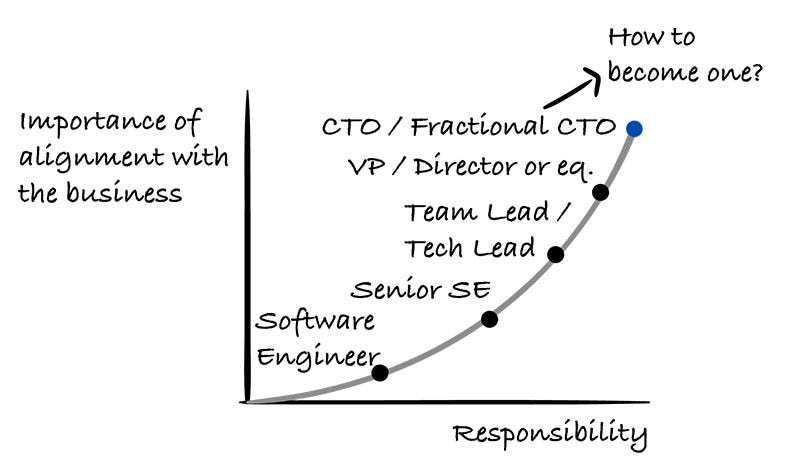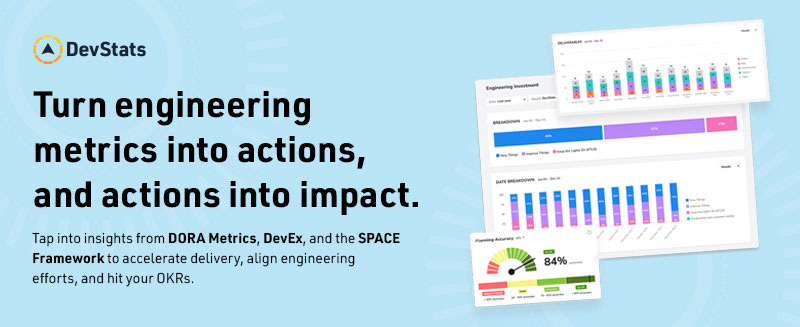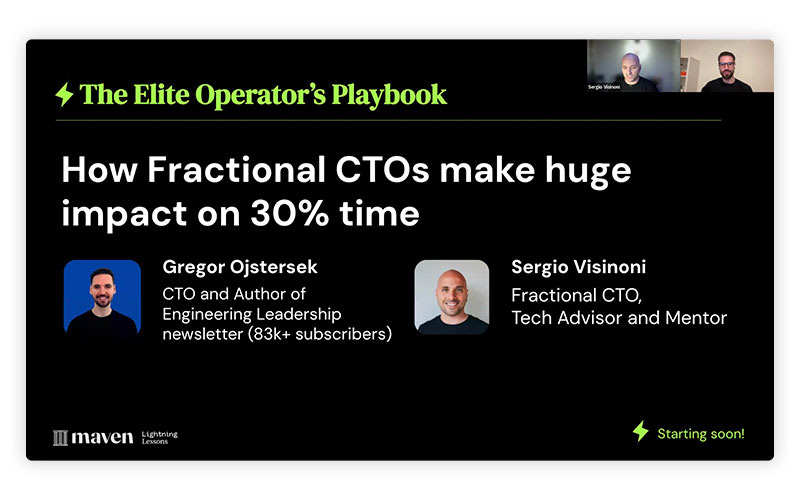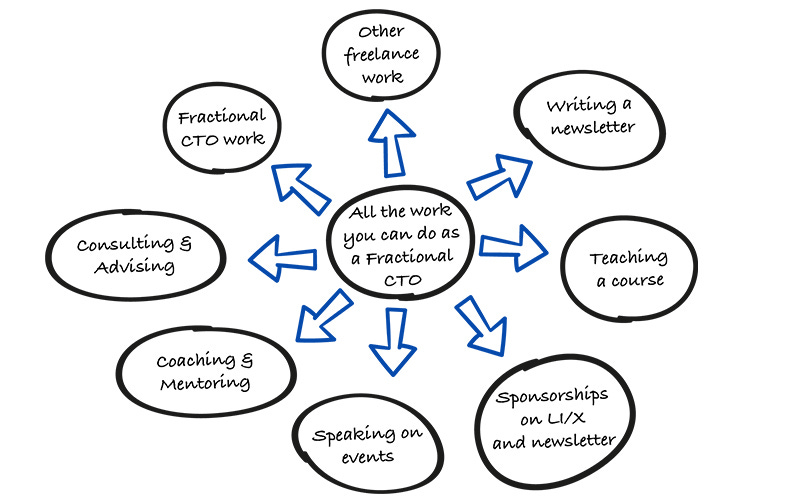How to become a Fractional CTO?
- Gregor Ojstersek and Sergio Visinoni from Engineering Leadership <gregorojstersek@substack.com>
- Hidden Recipient <hidden@emailshot.io>
DevStats (sponsored)With DevStats, you can Improve your process, identify bottlenecks, and ship better products, faster.
If you haven’t yet, I highly recommend checking DevStats out! No credit card is required to start your trial. Thanks to DevStats for sponsoring this newsletter. Let’s get back to this week’s thought. IntroRecently, there has been an increase in the popularity of fractional roles. I see this trend quite frequently → non-technical founder has an idea and hires a Fractional CTO to help them build it. Instead of going for the technical co-founder, they go for a Fractional CTO. The Fractional CTO then assesses the requirements and hires the right tech team needed to execute the idea. If the idea turns out to be successful, then the focus is on scaling and growing the team. And that’s where normally my suggestion is to think about bringing in a full-time CTO. In today’s article, we are going to go through what is a Fractional CTO and how can you become one! Together with Sergio Visinoni, Fractional CTO and author of Sudo Make Me a CTO, we did a lightning lesson How Fractional CTOs make huge impact on 30% time. The event was done in collaboration with Maven and in this article, we are doing a summary of what we talked about. You can check the recording here - forward the recording to about 7 minutes (that’s when the lesson starts and you’ll need to enter your email to view it). P.S. Today is also Sergio’s birthday 🎉🥳 I wish you a Happy Birthday and a great celebration. It’s been a real blast collaborating with you on this! Let’s go straight into the summary. What is a Fractional CTO?Both me and Sergio agree that there are many ways we can describe a Fractional CTO. Here is one way we could describe it:
The company that hires a Fractional CTO gets a person who is very experienced for less amount of $ than they would get for a full-time CTO who may be less experienced. That is the key difference. For some companies, especially smaller to mid-size companies, It's hard to afford a very experienced person full-time and that’s where a Fractional CTO becomes a good option. So it’s a matter of time vs experience vs compensation when assessing either having a Fractional or full-time CTO. How to become a Fractional CTO?It’s very important that you develop the much-needed experience first, before becoming a Fractional CTO. So suggestion from both me and Sergio is to become a full-time CTO first. Of course, it’s not mandatory to do that, but we believe you’ll have a much better time and overall success if you do that first. Here are 6 ways you can grow toward a CTO role: We wrote a detailed guide together with John Crickett regarding becoming a CTO here: 12 ways you can become a CTO (paid article). Sergio decided to become a Fractional CTO after 20 years of experience in the industryHe’s been covering a lot of leadership roles in technology all the way from 2013, roles spanning from Director, VP of Engineering and CTO. He worked for all different kinds of companies, from small, mid and all the way to enterprise companies. That gave him a lot of perspective. He’s seen what works in small teams and also what works in bigger teams. He took the decision to become a Fractional CTO this year in January to get out of the traditional 9 to 5 work setup. He believed there was a market for him and that's what he’s been doing since January. He currently has one Fractional CTO engagement, plus other more like consultancy advisory-type roles. A great thing about being a Fractional CTO is that you can do a lot of complimentary thingsSergio mentioned consulting. That’s a big part of what you can do because many companies are looking for external input on their processes, codebase, hiring, overall team, engineering culture, etc. And that’s also what I do a lot these days. Your experience and external input are very valuable for companies. Companies know and understand that spending a small amount of $ can save a large amount in the long term. You can also do coaching + mentoring and you can also work on something else in the time that you have available. For example, I am writing and continuously improving this newsletter + teaching a course Senior Engineer to Lead: Grow and thrive in the role. It’s up to you how you spend your time, that’s the greatest part in my opinion. That’s exactly the reason why I decided to become a Fractional CTO and Tech advisorI’ve had full-time roles for over 11 years in which I’ve been able to grow from engineer all the way to CTO and the big reason for that was freelance work:
That enabled me to develop broad experience in a much shorter amount of time and it played a big part in how I was able to grow from engineer all the way to CTO role. You can read more about it here: My secret for growing from engineer to CTO (paid article). In the last 2 years, while being a CTO, I was saying no to a lot of such opportunities, because I was doing a full-time role + I was also writing this newsletter, teaching a course and actively posting on LinkedIn / X. Now, I have much more time to focus on continuously improving this newsletter + my course and also spend time on various other things, mostly doing tech advising and coaching these days. This has already shown very positively on the growth of the newsletter and also I can really optimize my time on a daily basis. Plus, I am getting a lot of insights from various of different challenges that companies/individuals are facing, which helps me a lot to further expand my experience. Here are some stats of the newsletter changes from October to now:
Sincerely thank you for all of your support! If you wish to grow toward a Fractional CTO role, which skills do you need to develop?This was also the topic that we talked about with Sergio and I asked him exactly that. Sergio mentioned that he spends his time in about: 20-40% → Strategic planning and alignment
20-40% → Execution
20-40% → Team Management and development
How do you develop these skills?And then we also talked about how to develop these skills. This is what Sergio mentioned: Strategic planning and alignment
Execution
Team Management and development
We also answered many interesting questionsWe answered questions like:
Make sure to check out the recording to find out the answers! Here is the link to the recording - forward the recording to about 7 minutes (that’s when the lesson starts and you’ll need to enter your email to view it). Last wordsThanks to Sergio for the great collab → both on event and on this newsletter. Make sure to follow him on LinkedIn and subscribe to his newsletter Sudo Make Me a CTO. Let’s end this article with:
Liked this article? Make sure to 💙 click the like button. Feedback or addition? Make sure to 💬 comment. Know someone that would find this helpful? Make sure to 🔁 share this post. Whenever you are ready, here is how I can help you further
Get in touchYou can find me on LinkedIn or Twitter. If you wish to make a request on particular topic you would like to read, you can send me an email to info@gregorojstersek.com. This newsletter is funded by paid subscriptions from readers like yourself. If you aren’t already, consider becoming a paid subscriber to receive the full experience! You are more than welcome to find whatever interests you here and try it out in your particular case. Let me know how it went! Topics are normally about all things engineering related, leadership, management, developing scalable products, building teams etc. Invite your friends and earn rewardsIf you enjoy Engineering Leadership, share it with your friends and earn rewards when they subscribe. |
Similar newsletters
There are other similar shared emails that you might be interested in:





